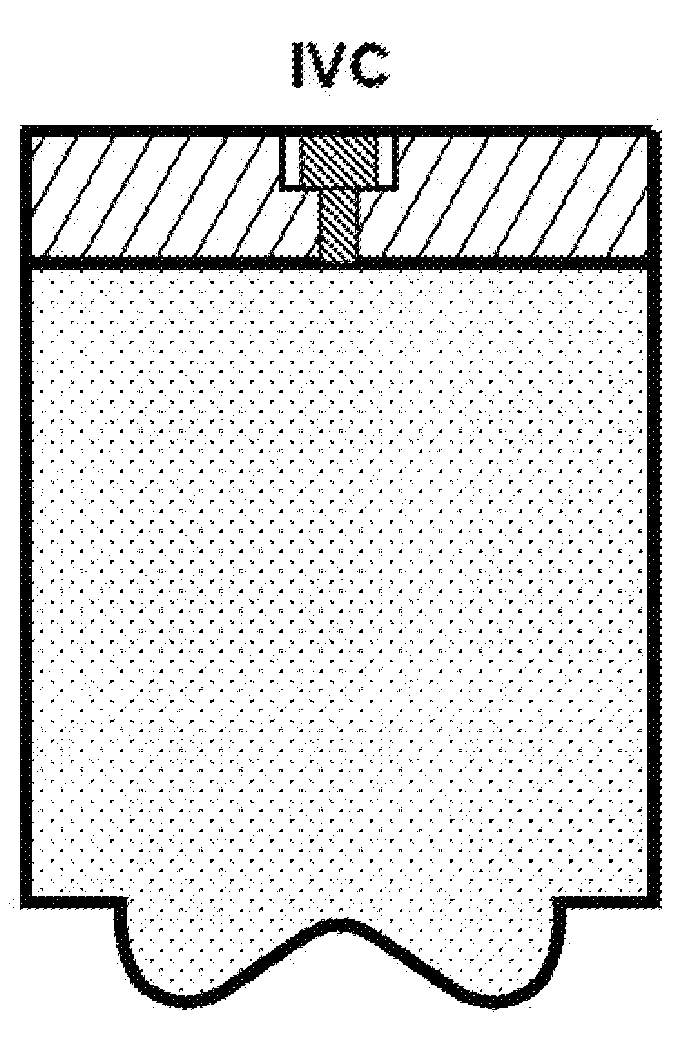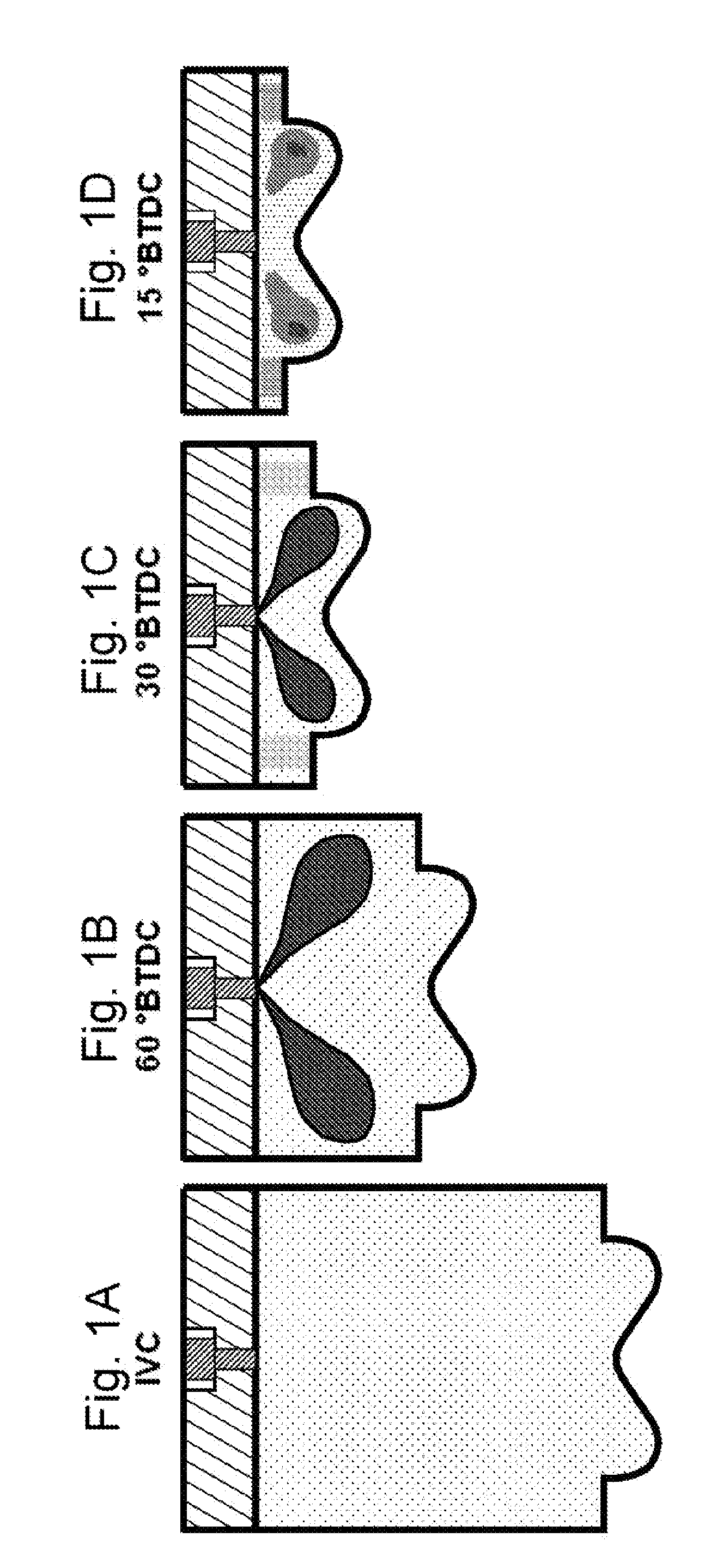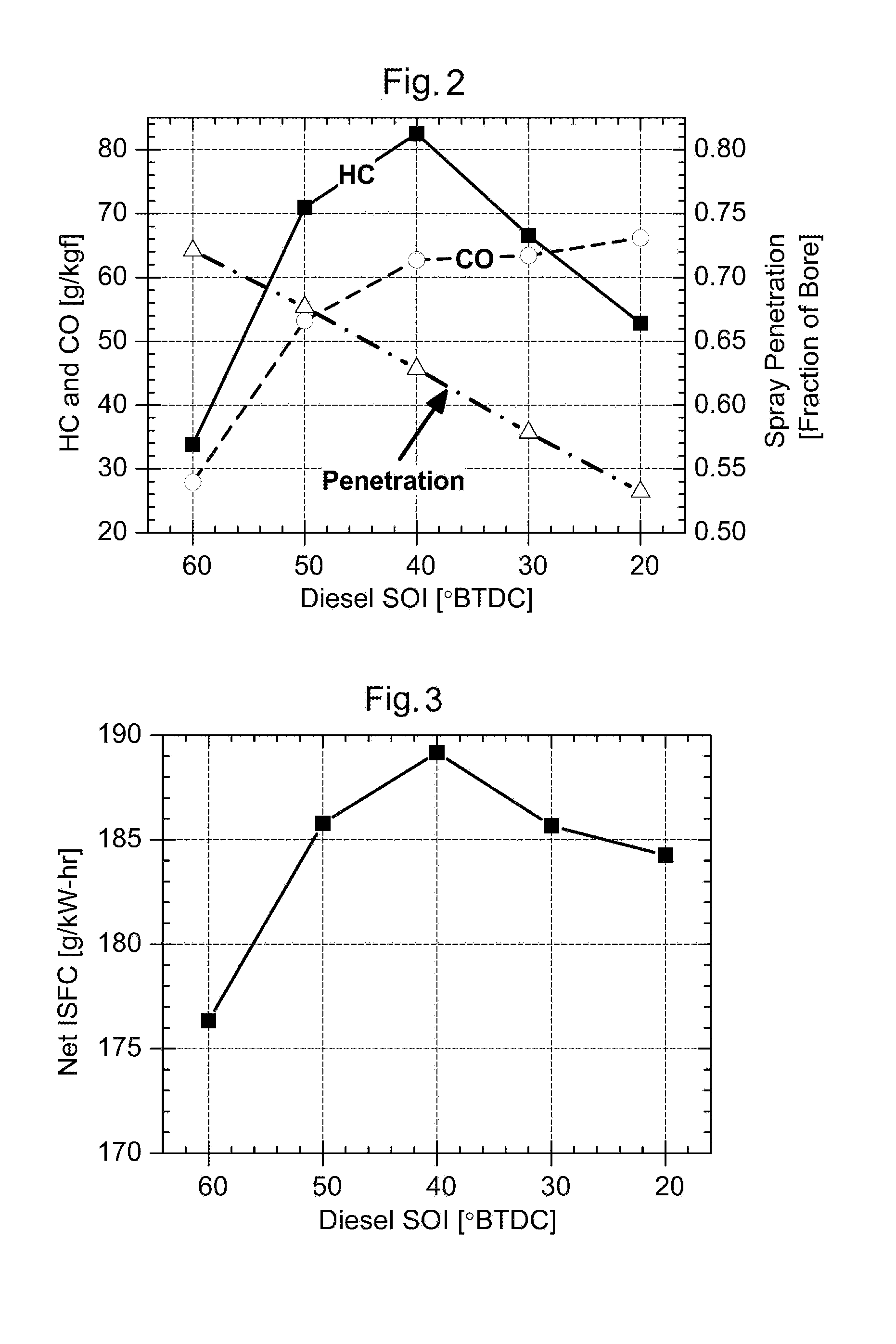[0012]In a diesel (compression ignition) engine, an initial fuel charge having a first reactivity—with the term “reactivity” generally corresponding to
cetane number, but being discussed in greater detail elsewhere in this document—is supplied to the
combustion chamber during the intake and / or compression
stroke, preferably sufficiently early that the initial fuel charge is highly premixed with the air in the
combustion chamber during a major portion of the compression
stroke. One or more subsequent fuel charges of different reactivity are thereafter supplied to the
combustion chamber in such a manner that a stratified distribution of fuel reactivity results within the combustion chamber, with distinct regions of higher and lower fuel reactivity. More specifically, the later different-reactivity charges are timed and otherwise designed to distribute the different-reactivity charges—which will be introduced into a preferably highly premixed “matrix” of air and first-reactivity fuel—in such a manner that the reactivity gradient within the combustion chamber provides a desired combustion
start time and rate (a time / rate that results in controlled heat release resulting in superior work input to the
piston), while deterring rapid pressure increases and high temperatures (which promote
NOx production and reduce fuel economy), and while completely burning all (or nearly all) fuel within the combustion chamber to reduce unburnt hydrocarbons.
Combustion tends to begin in one or more regions of highest reactivity (these regions being generated via the introduction of the higher-reactivity material), and spreads therefrom via volumetric energy release and / or
flame propagation until all fuel from all charges is consumed. Thus, tailoring of the reactivity distribution within the combustion chamber can allow tailoring of the nature of the
combustion process. Greater stratification /
gradation in reactivity tends to result in a lower combustion rate. Conversely, lower stratification /
gradation in reactivity (greater uniformity in reactivity throughout the combustion chamber) tends to result in a higher combustion rate, since each location within the chamber has an approximately equal chance of igniting first, and those that do not ignite first will be rapidly ignited by their neighbors.
[0018]Basically the same combustion mechanism results if the reactivities of the charges of FIGS. 1A-1D are reversed, i.e., if one or more initial higher-reactivity charges are followed by one or more subsequent lower-reactivity charges: ignition begins in the higher-reactivity regions and propagates to the lower-reactivity regions. The start and duration of combustion can be controlled by the timings and amounts of the fuel charges, which affect the degree of stratification attained. For optimal
work output, it is desirable that the fuel charges are supplied to the combustion chamber to attain peak
cylinder pressure at or after
Top Dead Center (TDC), more preferably between TDC and 20 degrees ATDC (After TDC), and most preferably between 5 and 15 degrees ATDC. In similar respects, CA50 (i.e., 50% of the total fuel
mass burned) preferably occurs between approximately 0 to 10 degrees ATDC. It is also useful to supply the fuel charges in such a manner that the rate of
pressure rise is no greater than 10 bar per degree of
crank angle rotation, since greater
pressure rise can generate unwanted
noise and more rapid
engine wear, and also promotes higher temperatures (and thus increased fuel consumption owing to
heat transfer losses, as well as NOx production).
[0019]Use of the foregoing methodology tends to result in much lower peak combustion temperatures—as much as 40% lower—than in conventional diesel engines, owing to the increased control over the
combustion process. This deters NOx formation, and additionally increases
engine efficiency because less
energy loss occurs from the engine through
heat transfer. Further, the reactivities, amounts, and timing of the fuel charges can be adapted to optimize combustion such that there is less unburned fuel left at the end of the expansion
stroke (and thus lost to the exhaust), thereby also enhancing
engine efficiency, and also generating less
soot.
[0020]An experimental version of the invention operating with diesel and
gasoline fuels has resulted in what is believed to be the most fuel-efficient
internal combustion engine currently known that is also capable of meeting governmental
soot emissions limits, NOx emissions limits, and fuel consumption limits for the year 2010 without the need for
exhaust gas after-treatment. As for emissions, the engine can readily attain EPA (U.S.
Environmental Protection Agency) standards (as defined on Jan. 1, 2010 at Part 1065 of Title 40 of the United States Code of Federal Regulations), including the EPA's emission standards for the
heavy duty transient Federal Test Procedure (FTP) (e.g., NOx emissions of less than 1.0 g / kW-hr and soot emissions of less than 0.1 g / kW-hr). Further reductions in emissions are possible if measures such as exhaust after-treatment are implemented. Looking to indicated
thermal efficiency as a measure of
fuel efficiency (indicated
thermal efficiency being a measure of the amount of fuel converted to output power by the engine, as opposed to being lost via
heat transfer, exhaust, or other variables), the engine has demonstrated a net
thermal efficiency of up to 53%, and a gross thermal efficiency of about 56%. (Net thermal efficiency takes account of
work output over the entire
engine cycle, whereas gross thermal efficiency only takes account of the expansion and compression strokes, with an approximately 3% difference between the two being common.) In contrast, at the time of this document's preparation, the average conventional
diesel engine has a thermal efficiency of approximately 42%, and the average
gasoline engine has a thermal efficiency of approximately 25-30%. The invention can therefore beneficially allow an effective reduction in fuel consumption of approximately 20%, while meeting United States emission standards (at least for the year 2010) without the need for burdensome and expensive engine modifications and / or after-treatment systems for soot and / or NOx reduction. It is of interest to note that while the invention operates using compression ignition (i.e., diesel operating principles), the exceptional efficiency was attained using more
gasoline than
diesel fuel: gasoline accounted for approximately 75%-90% of the total
mass of the fuel provided to the engine (at high loads), with the percentage of gasoline dropping to approximately 50% at low loads. Thus, a
diesel engine attained enhanced performance using primarily non-
diesel fuel. It is expected that in general, most common engines implementing the invention will use a greater proportion of low reactivity fuel than high reactivity fuel.
 Login to View More
Login to View More  Login to View More
Login to View More 


